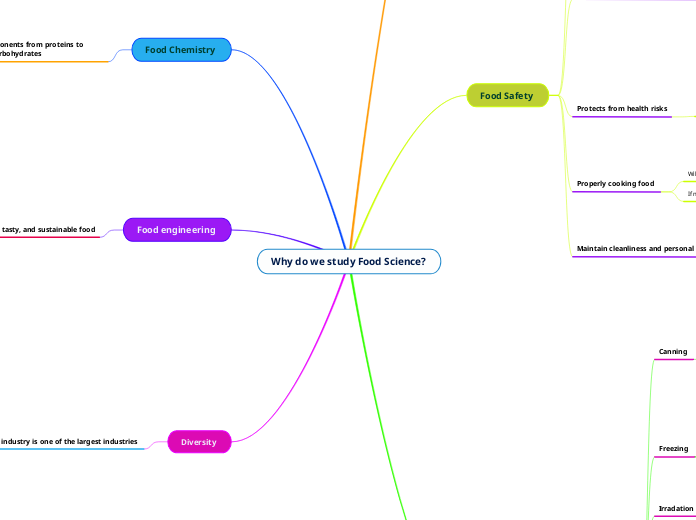
Reduce risk of chronic disease
Antioxidants
Vitamin C & E
Lycopene
Carotenoids
Fruits and Vegetables
Watermelon produce
more lycopene
Tomatoes reduce risk of
prostate cancer
Pytochemicals
Fruits and Vegetables
Cauliflower, Cabbage
Protect the body by stunning the growth of cells
Maintain a healthy body weight
Choosing appropriate foods
Rich in nutrients
Development and aging
Aging - deficiencies in calcium, vitamin D, vitamin B12
Keeps a healthy diet
Looking at nutirents to have a healthy diet
Following a diet plan
Rich in fruits and vegetables, whole grains, low-fat dairy
Supports normal growth
Proper nutrients aids brain development
Proteins and minerals
Calcium, iodine, iron
Keeping raw and cooked foods separate
Stops the bacteria from raw foods to re-contaminate cooked foods
Storing food at correct temperatures
Prevent bacteria
Cause sickness if not stored at correct temperature
Salmonella
Campylobacter
Staphylococcus aureus
E-coli
Slow growth of bacteria
Protects from health risks
Hurting yourself
Cut-resistant gloves
Freezer gloves
First aid kit
Knife caps
Oven mitts
Properly cooking food
Will kill harmful bacteria
If not done correctly could cause food poisoning
Maintain cleanliness and personal hygiene
Food poisoning
Spread of infection
Could spread bacteria when prepping, cooking or storing foods
Food contamination
Canning
Safe economical way to preserve food quality
Destroys enzymes
Kill and prevent growth of bacteria
Form high vacuums in cans
Kill yeasts and moulds
Remove oxygen
Freezing
Quick way to preserve fruits and vegetables
The cold slows the growth of microorganisms
Chemical changes changes quality or cause spoilage
Does not sterilize foods
Does not destroy organisms that cause spoilage
Irradation
Ionizing energy that passes through foods to kill bacteria and other organisms
Pickling and Fermentation
Changes colour
Change flavour
Lactic acid is produced which helps preserve the product
Change texture
Surface Disinfection
Chemicals are used to decontaminate the surface
Chlorine dioxide
Trisodium phosphate
Ozone
Organic acids
Hydrogen peroxide
Chlorine
Jelly & Pressrves
Gelled or thickened fruit
Low pH
Cooked and preserved with sugars
Fruit butters, jellies and jams
High Pressure
Foods are put through high isostatic pressure
Range of 100-600 MPa
Fresh Storage
Storage of fresh produce by refrigerating
Kill microorganisms
Minimize growth of microorganisms
Packing and storing to control respiration rate
Reduce enzyme activity
Drying
Oldest method of preserving foods
Remove water from foods
Prevent and kills growth of bacteria and enzymes
Circulate hot air through foods
Chemical components from proteins to carbohydrates
Fermentation of dairy products
Microorganisms process the conversion from lactose to lactic acid
Fat & Sugar Substitutes
Substitutes which offer the same taste without harming the body
Produce safe, healthy, tasty, and sustainable food
Refrigeration and freezing
Preserve the quality and safety of food materials
Freezing food slows the growth of bacteria that could potentially harm consumers
Evaporation
Increase the solid content
Dehydration prevents the growth of moulds in food
Reduce the water content of food
Change the colour
Packaging
Used for cans or jars
Extend the shelf-life of products, to stabilize food
Energy for food processing
Reduce energy consumption, reduce production costs, and improve the sustainability in food production
Thermodynamic cycles
Non-thermal heating processes
Heat transfer in food processing
Preserve the hygienic, nutritional and sensory qualities of food
Create variations in the physical properties of food when freezing, baking, or deep frying products
Convection
Induction
Radiation
Food industry is one of the largest industries
Have multiple job opportunities
Marketing
Teaching
Safety
Quality management
Nutrition
Sales